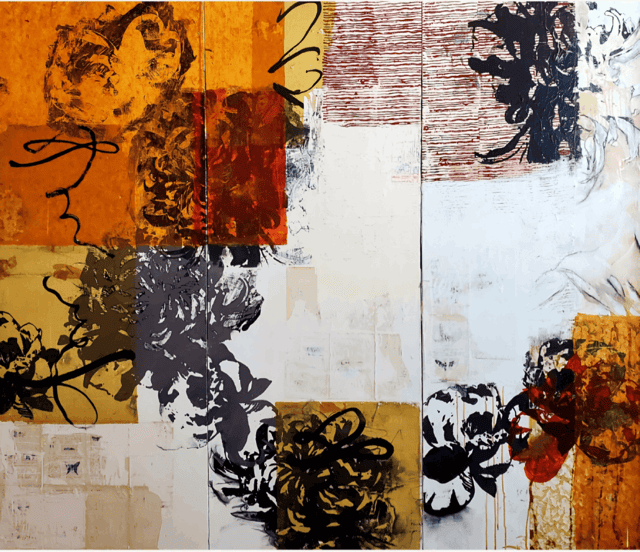Diane Williams, a Bay Area painter, invites viewers into an intimate dialogue between the visible and the invisible. Her mixed-media paintings are not just visual experiences; they are meditations on nature, memory, and the unseen forces that connect human experience to the wider world. As a graduate of the Arts and Consciousness program at John F. Kennedy University, Williams approaches her art with a profound sense of introspection. Each canvas becomes a vessel where spiritual inquiry, ecological awareness, and personal history merge into a single, resonant language.
Her creative process reflects the same curiosity and sensitivity that once guided her through 26 years of work in the hospital environment. There, she witnessed both the fragility and resilience of life. These experiences deeply inform her artistic vision, imbuing her works with emotional depth and a quiet reverence for transformation. In her paintings, grief and renewal coexist interwoven like the layers of paint, paper, and texture that define her visual vocabulary.
The Intersection of Nature and Memory
At the heart of Williams’s work lies a dialogue with nature, its cycles, its metaphors, and its ability to mirror the human spirit. Her paintings often feel alive with organic movement: flowing lines, translucent layers, and subtle shifts in tone that evoke the passage of time. Through these elements, she reveals how the natural world is not separate from our inner lives but deeply intertwined with them.
Williams’s art suggests that memory is also a kind of landscape, ever-changing, textured, and fertile with the traces of what has been lived and felt. She collects fragments from her past vintage book pages, old papers, and materials gathered from her travels and integrates them into her compositions. These elements serve as visual metaphors for remembrance and continuity, grounding the ethereal aspects of her practice in tangible, historical material.
A Bridge Between Cultures and Traditions
A significant influence on Williams’s artistic evolution comes from her time studying in China. Immersed in the traditions of calligraphy and Eastern aesthetics, she discovered new ways to think about mark-making not as mere decoration, but as a meditative act, a way of aligning body, mind, and spirit. This sensibility continues to inform her work, where each brushstroke feels deliberate and infused with intention.
She often integrates fragments of calligraphy into her mixed-media pieces, not as legible text but as symbols of rhythm, energy, and flow. The act of layering these with Western materials, acrylics, collage, and textured papers creates a dialogue between cultures, a synthesis of East and West that mirrors her broader artistic pursuit of unity within diversity.
“The Vibrant Flower Evades the Injurious Insect”
One of Williams’s most compelling works, The Vibrant Flower Evades the Injurious Insect, encapsulates her artistic philosophy. This triptych, created with acrylics and mixed media on canvas, unfolds as a meditation on endurance and grace. Its title alone suggests the resilience capacity of beauty to persist even in the presence of harm.
The surface of the painting carries a tactile richness, layered with personal and cultural artifacts: practice calligraphy created during her time in China, vintage book pages that whisper fragments of forgotten stories, and delicate mulberry paper that softens the composition like a breath between layers. These materials come together to form a textured palimpsest, a surface alive with traces of memory, both personal and collective.
In this work, language and image converge. The inclusion of calligraphic gestures introduces a sense of rhythm and temporality, while the vintage papers hint at cultural memory and intellectual lineage. The result is a harmonious balance between tradition and innovation, structure and spontaneity. The painting’s quiet strength lies in its ability to suggest transformation: that from fragility can come resilience, and from decay can emerge renewal.
Art as Healing and Connection
For Diane Williams, art is more than aesthetic; it is a practice of healing. Her years of working in a hospital environment brought her face-to-face with life’s most vulnerable moments. That intimate awareness now informs her creative process, where painting becomes an act of compassion, reflection, and renewal. She approaches each canvas as a space for emotional processing a place where grief can transform into gratitude, and the unseen currents of the soul can find form and color.
Beyond her personal practice, Williams shares this philosophy through teaching and workshops, encouraging others to explore creativity as a means of connection and self-discovery. Her students often describe her approach as both grounding and liberating, an invitation to embrace imperfection and to see art as a living conversation with the self and the world.
Cycles of Transformation
Transformation is not merely a theme in Diane Williams’s art; it is its essence. Whether through her choice of materials, her layering technique, or the spiritual undertones of her imagery, she continuously explores how beauty emerges from change. Her works invite the viewer to slow down, to look closely, and to witness the delicate balance between what endures and what fades away.
In blending the spiritual with the material, the personal with the universal, Diane Williams offers a vision of art that transcends boundaries. Her paintings remind us that the act of creation is, at its core, an act of renewal, a way of honoring the past while embracing the infinite possibilities of transformation.


